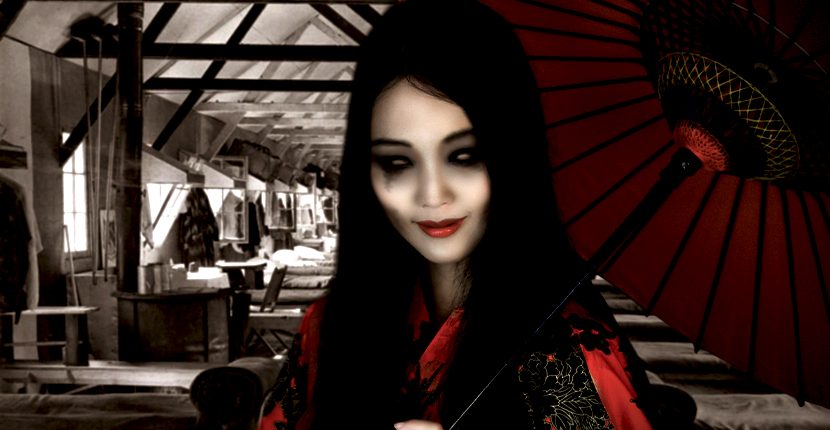In the new AMC series The Terror: Infamy, set in a California internment camp for Japanese Americans during World War Two and premiering on Aug. 12 at 9/8c, a series of unexplained deaths raises the possibility of a haunting, one that points to the legends of an eerie Japanese supernatural being called a Yūrei.
Similar to the ghosts flitting through Western mythology and culture, the Yūrei has special qualities that makes it as fascinating—and as frightening–as a supernatural being from anywhere in the world. But the history of this Japanese entity has special qualities.
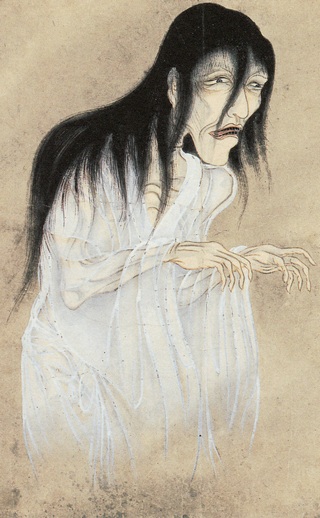
“The worlds of the living and the dead are perhaps nearer to each other in the Japanese conception than they are in Western belief systems,” according to the website Multo. “Your obligations to your ancestors continue past their deaths — and perhaps their interest in your life outlives their deaths, too.”
When a person dies, the Japanese tradition suggests that the person is transformed into a spirit, but not anything that necessarily comes back to haunt the living. So what is a Yūrei? A spirit that becomes stuck in a form of purgatory and haunts the living until released.
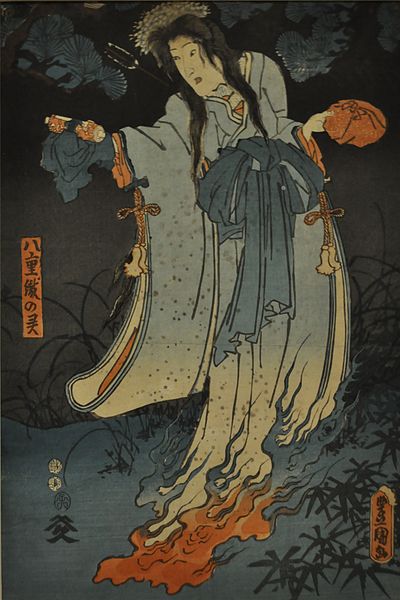
The spirit makes its way through the afterlife because of a series of funeral and post-funeral rites and prayers. The Yūrei appears when the person has failed to receive the proper funeral rites, some say. But another belief is that if a person dies suddenly, violently, or with the emotions of malice, jealousy, or sorrow in his heart, he cannot pass through this purgatory no matter what rites are performed and is transformed into a Yūrei.
What kind of hauntings take place? It can run the gamut from lights going on and off and strange sounds being heard to terrifying acts of vengeance, such as the story of a Yurei who was a first wife cutting off the head of a second wife because the husband promised never to remarry.
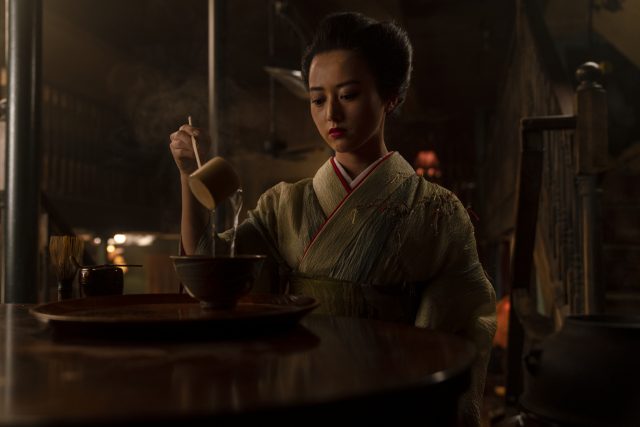
The Yūrei is usually female and appears to the living as she was when buried: wearing a white kimono, with black hair loose and tangled. In some depictions, she has black veins stretching across her pallid face and hands that dangle lifelessly from wrists. They appear to have no problem passing between the boundary separating the living from the dead, although that barrier is said to be thinnest between 2 and 2:30 AM. They can also crawl across ceilings or up walls in defiance of gravity. They often move in a peculiar, disjointed manner, and can disappear in the blink of an eye. They also sometimes exhibit a precursor, a smell or sound that can alert humans to their approach.
Laying a Yūrei to rest is no easy matter, though the legends say that certain rituals can be effective, as well as resolving the emotional pain that the person suffered just before death.
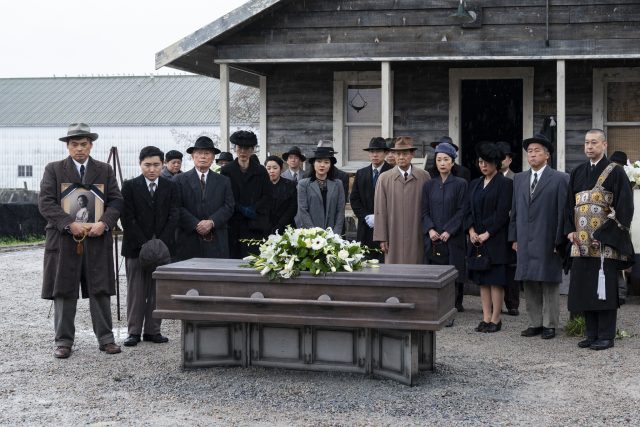
Western movie audiences got an eyeful of ghosts with Yūrei-like properties in the 2002 horror film The Ring (a remake of a Japanese film) and 2004’s The Grudge (also a remake). However, both of those films’ creations were more like another supernatural called Onryō, a ghost seeking vengeance and tied to the physical plane by anger.
The Yūrei have deep roots in history. Two of Japan’s oldest books, the 12th century Genji Monogatari (Tale of Genji) and Konjaku Monogatari (Tales of Times Now Past), contain characters who are Yūrei. In Genji Monogatari, a prince is haunted by the Lady Rokujō, whose love he rejected. Konjaku Monogatari is an esteemed collection of supernatural tales that have inspired Japan’s writers for centuries.
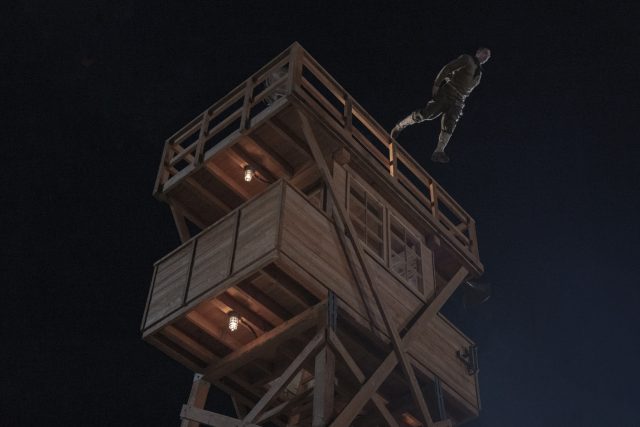
In Maruyama Ōkyo’s famous 18th century painting The Ghost of Oyuki, the modern image of the Yurei is presented: pale, wearing white, limp hands. According to the story connected to the painting, Okyo had a mistress who died young and Okyo grieved deeply. Her spirit appeared to him in a dream one night as a Yurei and, to try to deal with his sorrow, he painted her portrait.
In 1776, Ueda Akinari adapted stories from Konjaku Monogatari as well as other classic supernatural tales into one of the greatest works of world literature, Ugetsu Monogatari — Tales of Moonlight and Rain. In the modern era, it seems as if many Japanese writers have a Yūrei tale to tell. Kawabata Yasunari, who won the Nobel Prize for literature, wrote a story in which a beautiful young Yūrei and an old man, her former lover, take a walk while talking about her suicide.
Check out the spooky trailer for the upcoming season of AMC’s The Terror below:
Many historic places in Japan have legends of spirits. The Himeji Castle, a beautiful UNESCO heritage site, offers the Well of Okiku, which figures in one of Japan’s best known Yūrei legends. Okiku was a servant in the service of a samurai named Tessan who fell in love with her. After he tried to force her to become his mistress, she committed suicide by diving into one of the castle’s wells.
Related Article: AMC Series ‘The Terror’ Returns Inside a WWII Japanese-American Internment Camp
Since the night of Okiku’s suicide, people have said they saw her emerge from the well, either to count or to shriek, before descending to its depths. Sightings are most common in August, which is said to be the favorite month for any Yūrei to show itself.
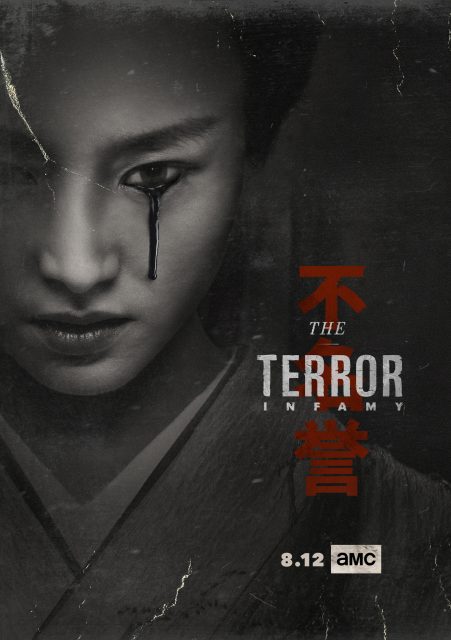
For more info on the new season of AMC’s The Terror please visit their official website
Nancy Bilyeau, a former staff editor at Entertainment Weekly, Rolling Stone, and InStyle, has written a trilogy of historical thrillers for Touchstone Books. Her new book, The Blue, is a spy story set in the 18th-century porcelain world. For more information, go to www.nancybilyeau.com
